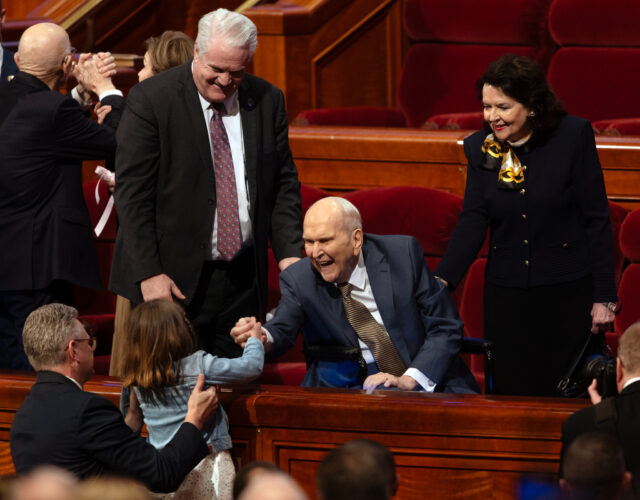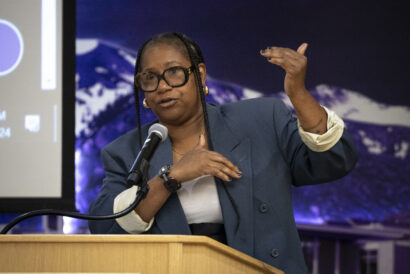‘You couldn’t help but connect with him’: A BYU professor reflects on Russell M. Nelson’s legacy as Latter-day Saint prophet

Photo supplied, Intellectual Reserve
Russell M. Nelson, president of The Church of Jesus Christ of Latter-day Saints, shakes the hand of a little girl at the conclusion of the afternoon session of general conference at the Conference Center in Salt Lake City on Sunday, April 6, 2025.Former president of The Church of Jesus Christ of Latter-day Saints Russell M. Nelson oversaw many changes during his seven-year tenure as prophet, including shortening Sunday church meetings to two hours, replacing home teaching with ministering and placing an emphasis on the church’s official title.
His legacy will be less about his policy accomplishments, though, and more about how he taught the church’s doctrine to its members, according to Brigham Young University professor Mary Jane Woodger.
Woodger, who has written several books and articles on church history and its leaders, believes Nelson endeared himself so thoroughly to church members by connecting with each one of them on a personal level.
In some of his most memorable general conference talks, including “Peacemakers Needed,” “Let God Prevail” and “Hear Him,” Woodger said Nelson did not just tell church members what to do; rather, he showed each member what they could become.
“Yes, he was the prophet for the whole church, but what he was asking me to do was so individual and so personal that you couldn’t help but connect with him in such an amazing way,” she said.
While giving his talks, Nelson offered challenges and then follow them with promises, according to Woodger. In his 2018 talk “Revelation for the Church, Revelation for Our Lives,” he challenged members to increase their spiritual capacity and seek revelation and promised those who did would be “guided in matters large and small.”
Woodger saw her students at BYU latch on to Nelson’s different challenges in their own lives. She assigned students to choose counsel Nelson had given and work on it during the semester.
“I always get such remarkable reports in the end,” Woodger said. “‘President Nelson said if I went to the temple I would regain confidence and strength.’ … And they always report that they’ve done what he told them to do and it’s happened.
“We’ve never had a prophet who has given more challenges but then promises.”
She added that Nelson empowered women in the church, teaching them they had access to priesthood authority and power despite not being ordained to the priesthood like men in the church.
Nelson was not baptized in the church until he was 16, and he said his parents were not sealed in the temple until his father was 80. Woodger believes his background made temple sealings a high priority and said he spoke about it in his 2000 “Living Christ” testimony.
She suspects his life experience influenced the 200 temples he announced during his tenure as church president.
“President Nelson said when he was born there were only six temples,” Woodger said. “Well, he comes along and in seven years announces 200. I mean, that’s just phenomenal. And you really heard from him, ‘You’ve got to get to the temple. You’ve got to be in the temple. You’ve got to be prepared, and you’ve got to have those blessings.'”
Nelson’s attention on the individual also had a direct impact on Woodger’s profession in two ways.
In 2019, the First Presidency released the “Strengthening Religious Education in Institutions of Higher Education” document, which laid out the principles and guidelines of a church education. Woodger said it was the first time in her 27 years of teaching she had received such a directive from the First Presidency.
“I’ve never seen anything that has had such an effect on my teaching, and not on just our teaching, but on the students,” she said. “And (Nelson’s) concern was for the students and that they received the education they deserve, and so he’s been very hands on.”
The second impact came when Woodger was writing a book on the courtship of prophets and needed permission to access church pictures. She reached out to Nelson’s office and got a response directly from him.
“He personally said, ‘What pictures do you need?’ I mean, here’s the prophet, and I’m writing this dumb little book. And he asked, ‘What can I do? What do you need? I’m happy to send you anything,'” Woodger said.
Throughout his leadership, Woodger said Nelson “was never old,” despite becoming church president at 93. Like many church members, she is mourning his death.
The church will now reorganize its leadership. According to Woodger, the Quorum of the Twelve Apostles traditionally meets after the prophet’s funeral, and the senior apostle — currently Dallin H. Oaks — decides when to reorganize and become the prophet.
However, in this instance, general conference — where church members sustain leaders — will occur Saturday and Sunday, prior to Nelson’s funeral on Tuesday.
Woodger said she isn’t sure how Oaks will navigate the timing.
“It’ll be interesting, especially with general conference, because the prophet isn’t really the prophet until we have the solemn assembly and he’s sustained. He’s not only ordained, but he’s sustained by the membership of the church, and so I don’t know if they’ll want to wait six months to hold that solemn assembly and sustain President Oaks.”



